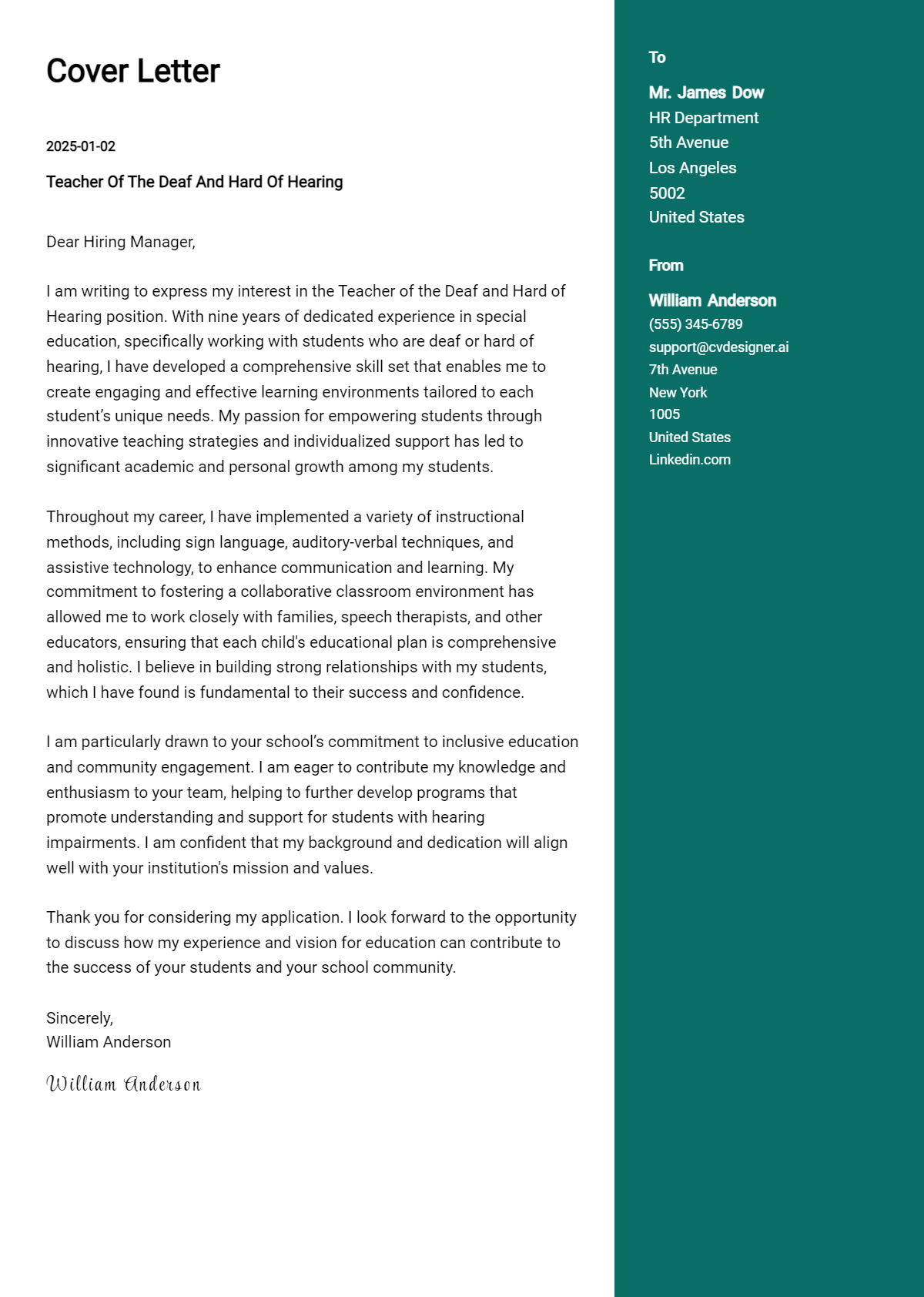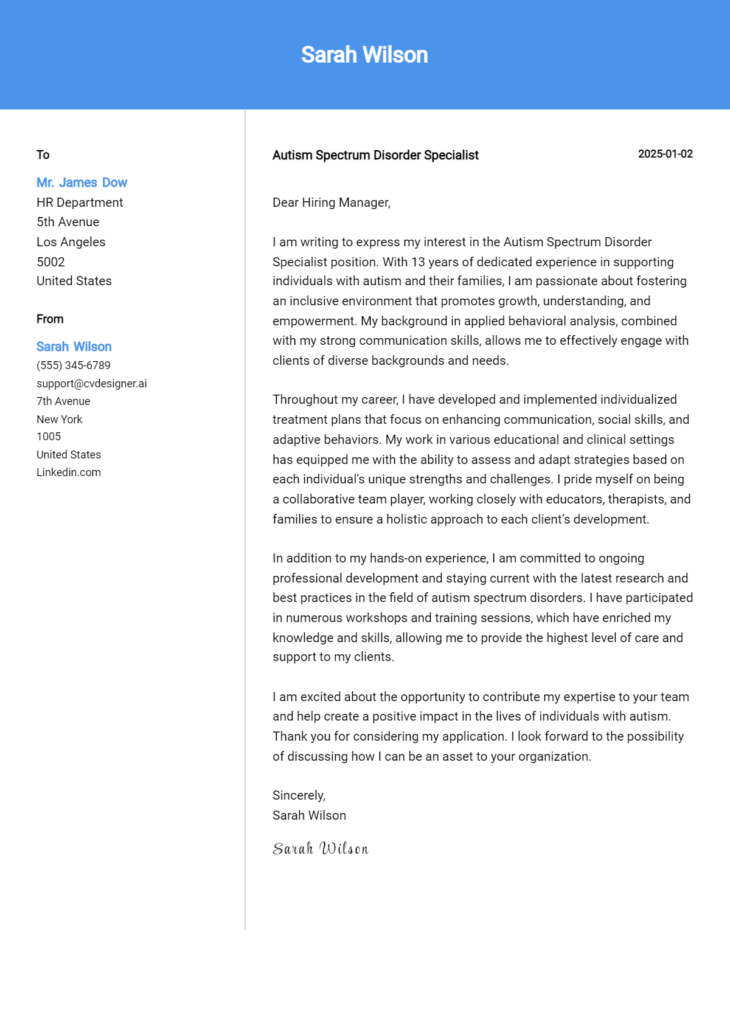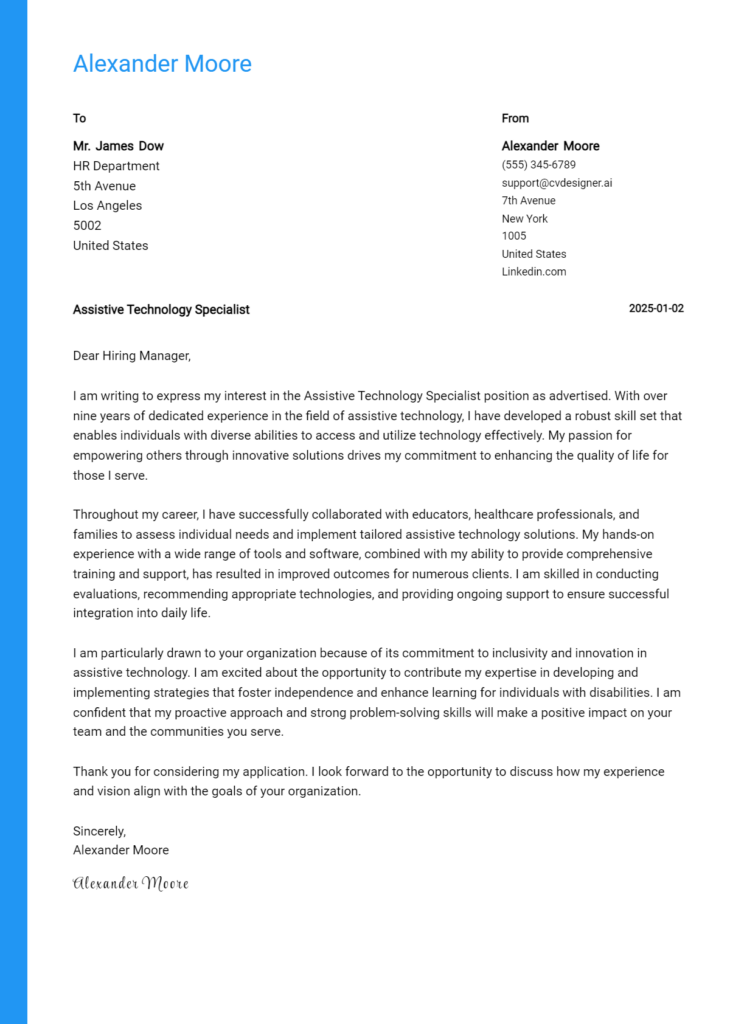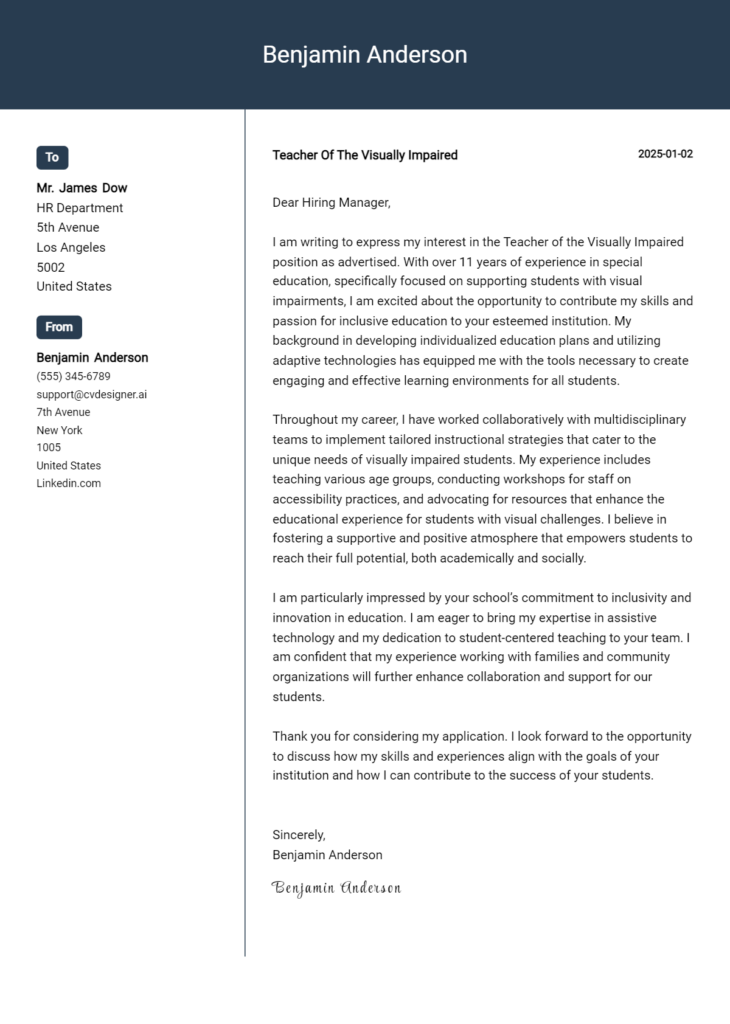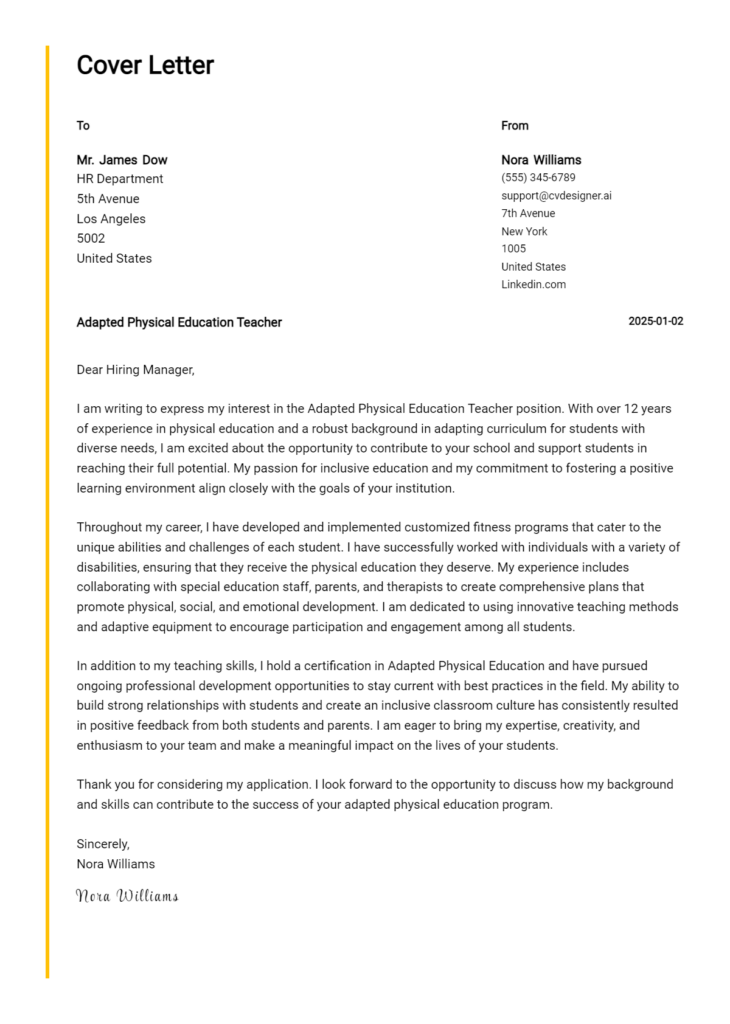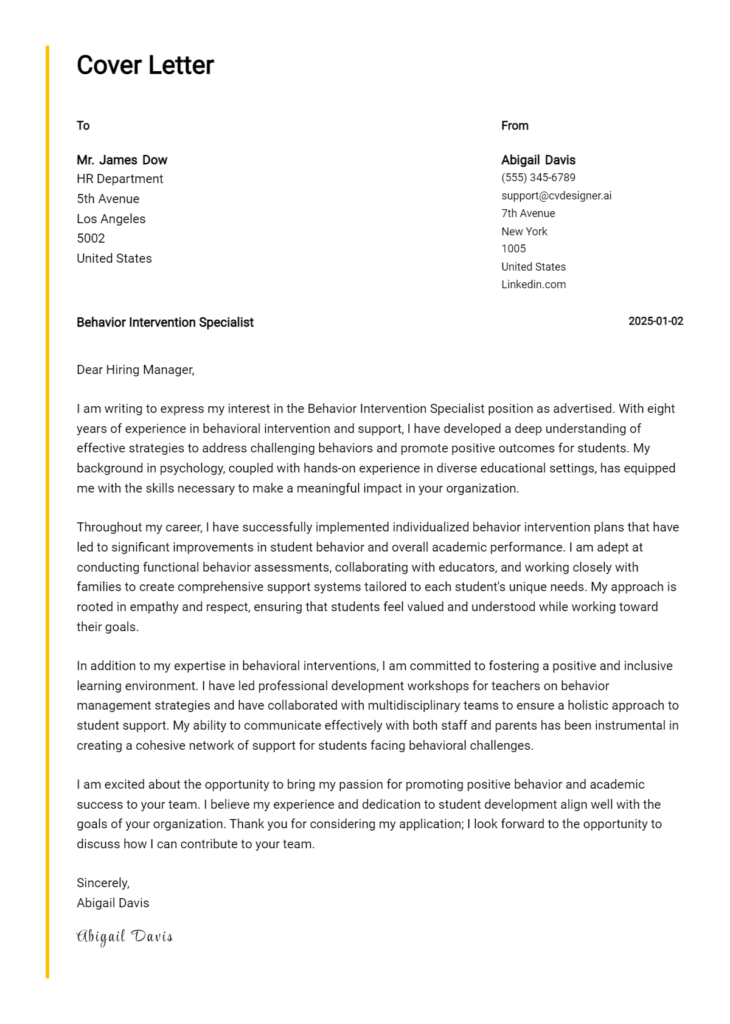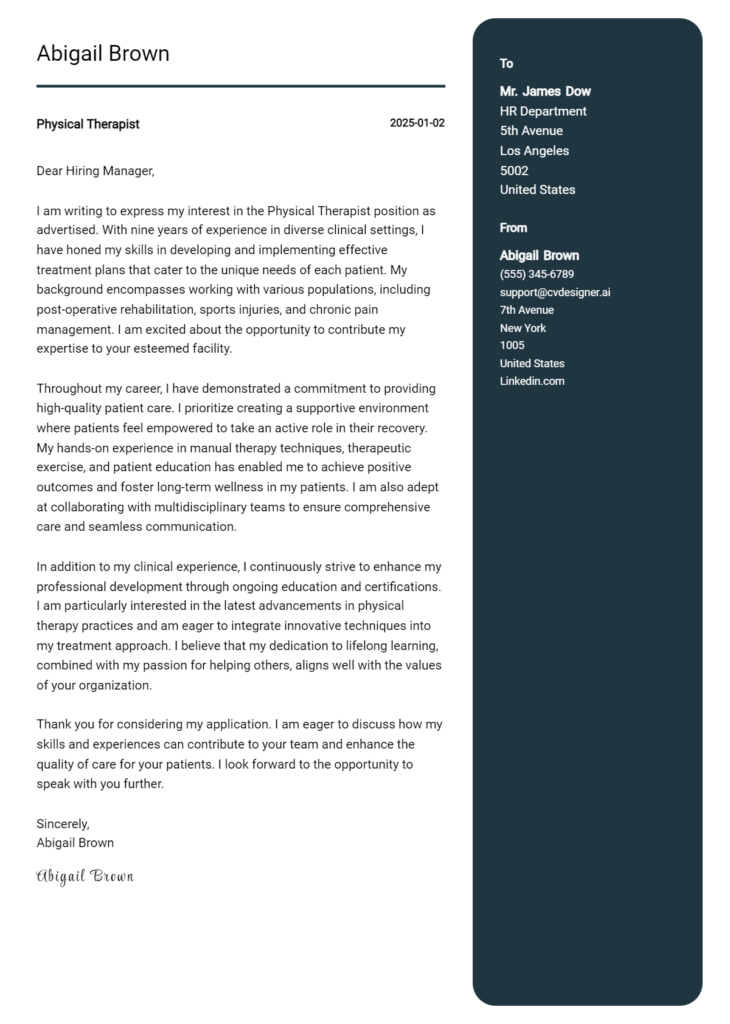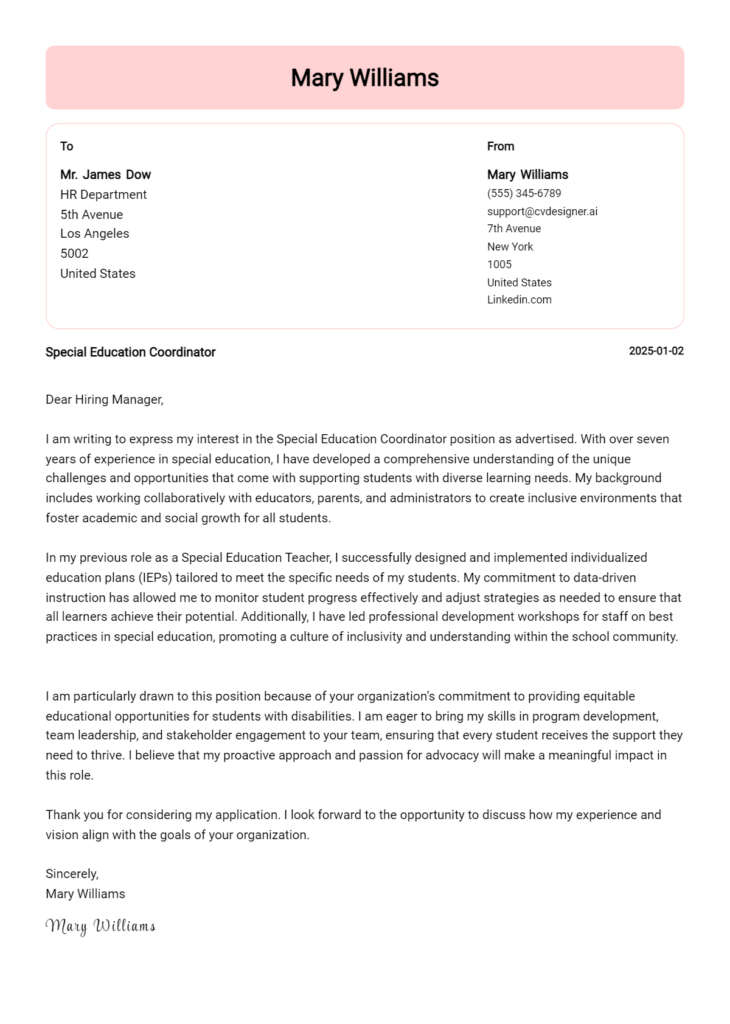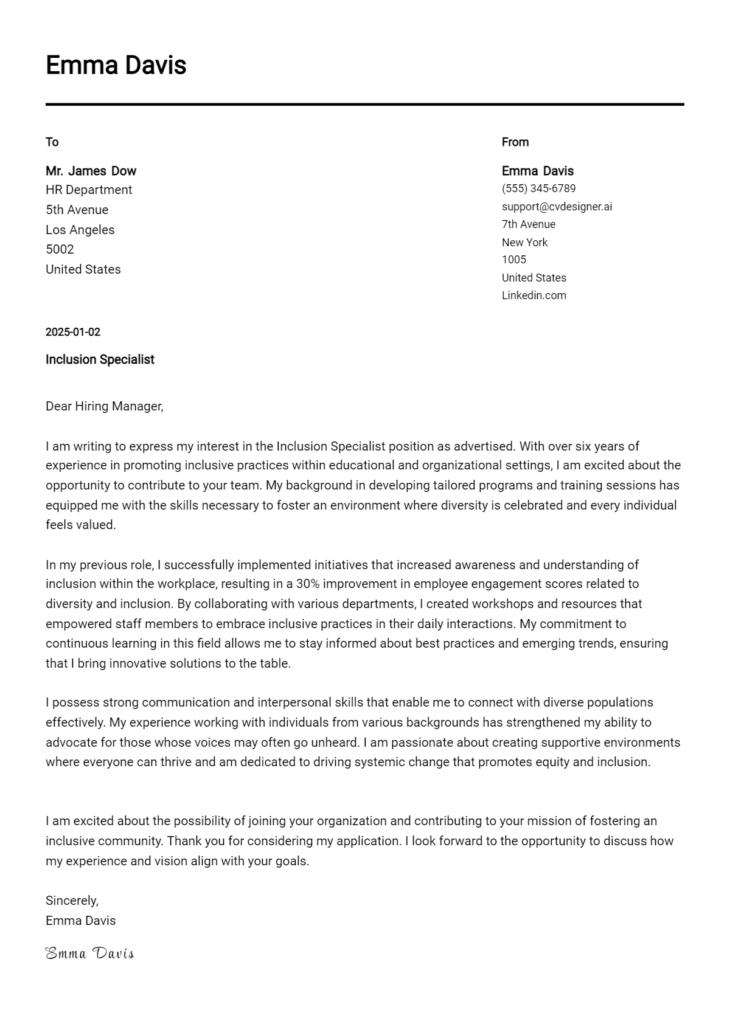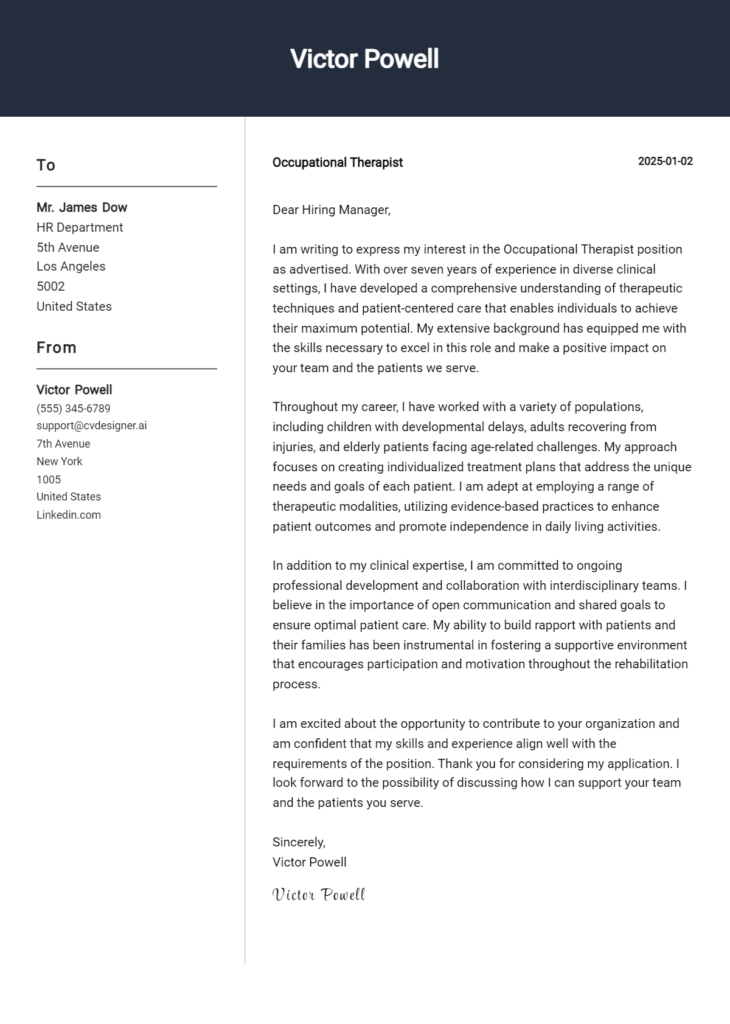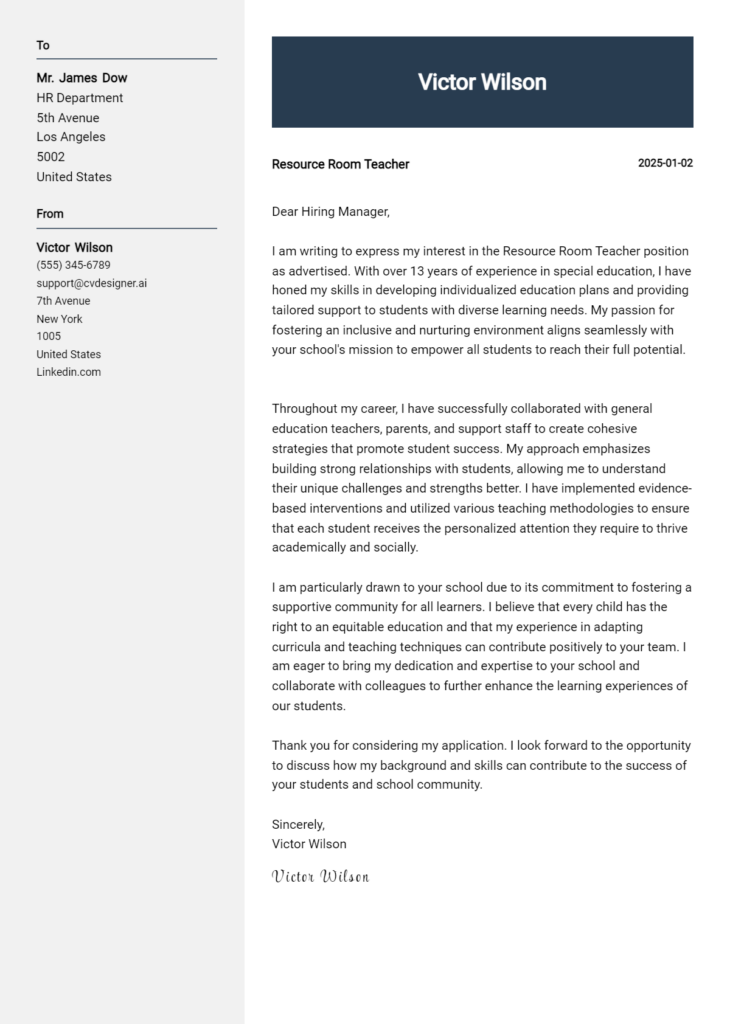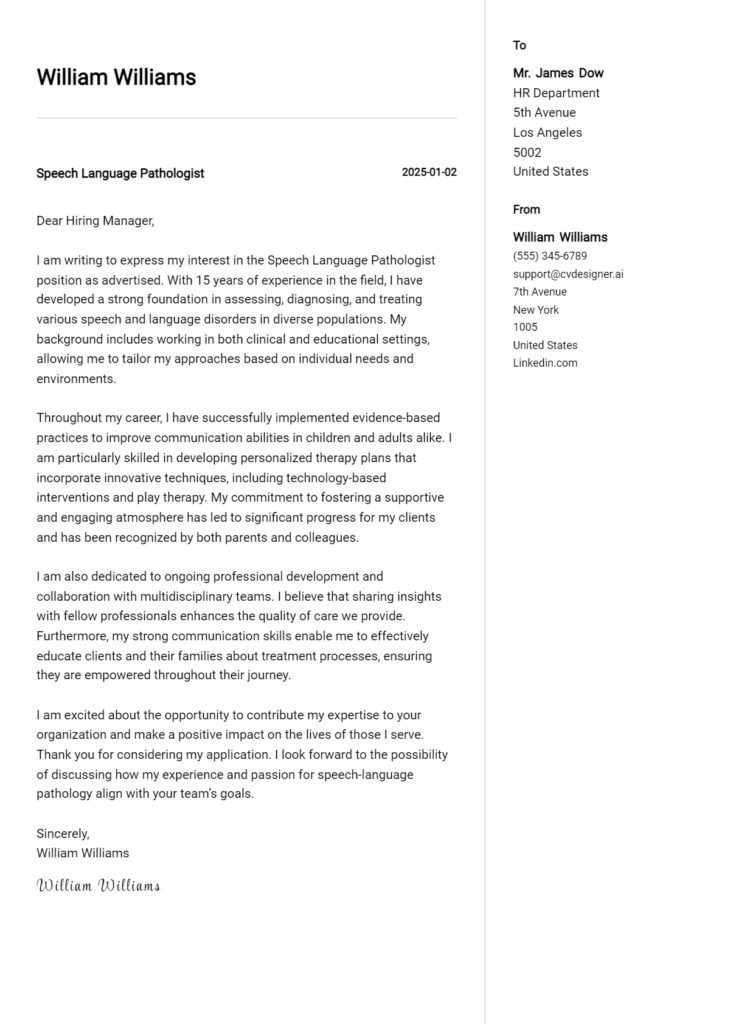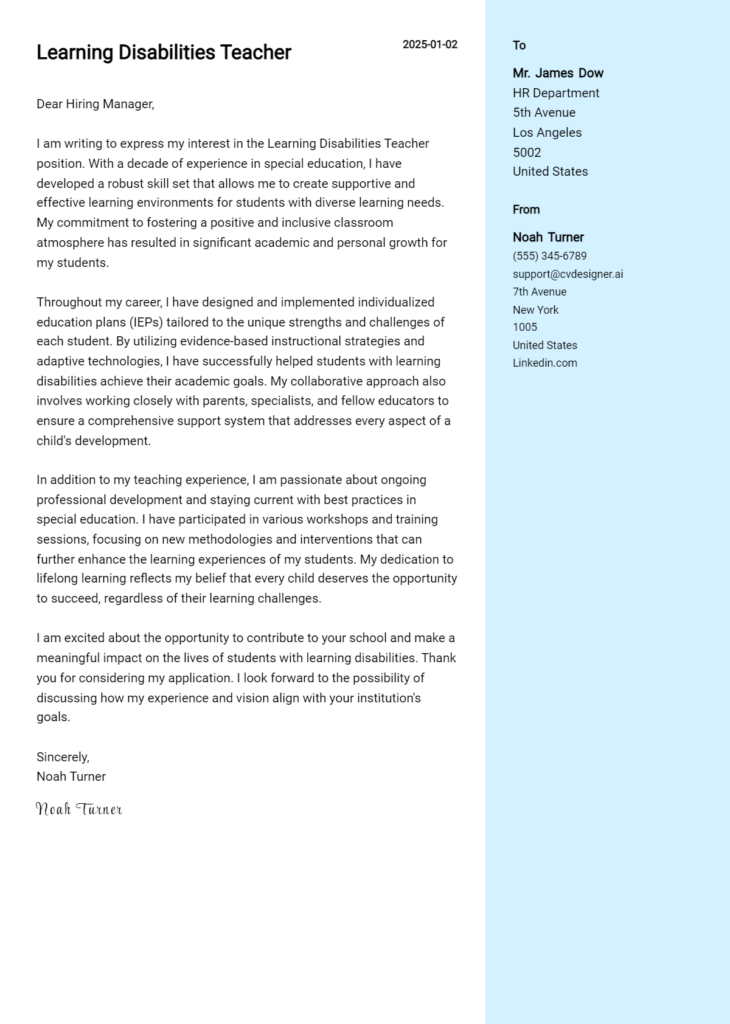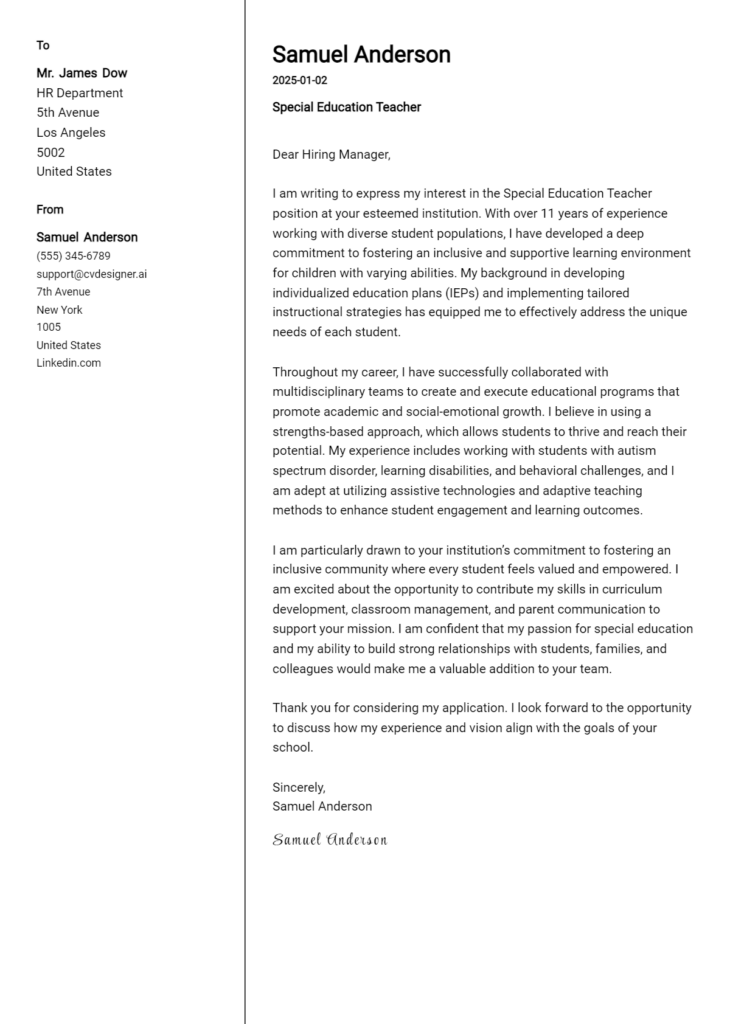Teacher Of The Deaf And Hard Of Hearing Cover Letter Examples
Explore additional Teacher Of The Deaf And Hard Of Hearing cover letter samples and guides and see what works for your level of experience or role.
How to Format a Teacher of the Deaf and Hard of Hearing Cover Letter?
Crafting a compelling cover letter is essential for a Teacher of the Deaf and Hard of Hearing, as it serves as your first opportunity to demonstrate your passion for inclusive education and your specialized skills. Just as effective communication is vital in the classroom, the formatting of your cover letter reflects your organizational abilities and attention to detail—qualities that are paramount in supporting students with hearing challenges. A well-structured cover letter not only grabs the hiring manager’s attention but also showcases your commitment to fostering an accessible learning environment.
In this guide, we’ll outline how to format your cover letter effectively, providing insights and field-specific examples to help you create a persuasive document.
We’ll focus on the essential components of a professional cover letter, including:
- Cover Letter Header
- Cover Letter Greeting
- Cover Letter Introduction
- Cover Letter Body
- Cover Letter Closing
Each section is crucial in emphasizing your qualifications and professionalism. Let’s delve into each part and discuss how to make your cover letter shine.
The Importance of a Cover Letter Header for a Teacher of the Deaf and Hard of Hearing
The cover letter header plays a crucial role in establishing a professional tone and ensuring that your application is taken seriously. It serves as the first point of contact with potential employers, setting the stage for the content that follows. A well-structured header should include your contact information, the date, and the recipient's details. Clarity and professionalism are key; an organized header makes it easy for the reader to know who you are, how to reach you, and when you applied.
Here are examples of a strong and weak cover letter header for a Teacher of the Deaf and Hard of Hearing:
Strong Example
Jane Doe 1234 Elm Street Cityville, ST 12345 (123) 456-7890 jane.doe@email.com October 1, 2023 Mr. John Smith Hiring Manager School for the Deaf 5678 Oak Avenue Townsville, ST 67890
Weak Example
jane doe 1234 elm street Cityville 10/1/23 to whom it may concern
In the strong example, the header is complete, professional, and easy to read, while the weak example lacks proper formatting, capitalization, and specific recipient details, which could detract from the applicant's perceived professionalism.
The Importance of a Cover Letter Greeting for a Teacher of the Deaf and Hard of Hearing
The greeting of your cover letter serves as the first impression you make on the hiring manager and sets the tone for the rest of your application. A well-crafted greeting demonstrates your professionalism and shows that you have taken the time to personalize your letter, which is especially important in a field that values individualized attention, like teaching the deaf and hard of hearing. Addressing the hiring manager directly can make your cover letter stand out and convey genuine interest in the position. To avoid sounding generic, it's crucial to research the recipient's name whenever possible. A personalized greeting indicates that you are not only serious about the job but also respectful of the hiring process.
Strong Greeting Example
Dear Ms. Johnson,
Weak Greeting Example
To Whom It May Concern,
By incorporating these tips and examples into your cover letter, you ensure that your application begins on a positive note, reflecting your suitability for the role of Teacher of the Deaf and Hard of Hearing.
Cover Letter Introduction for Teacher of the Deaf and Hard of Hearing
A well-crafted cover letter introduction is crucial for a Teacher of the Deaf and Hard of Hearing, as it serves as the first impression to the hiring manager. This opening paragraph should not only capture their attention but also convey the candidate's genuine interest in the role. It’s an opportunity to briefly highlight key skills, experiences, or achievements that make the candidate an ideal fit for the position. A strong introduction sets the tone for the rest of the cover letter, encouraging the reader to learn more about the applicant's qualifications and dedication to supporting students with hearing challenges. Below are examples of both strong and weak introductions to illustrate the impact of a compelling opening.
Strong Example
Dear [Hiring Manager's Name], I am excited to apply for the Teacher of the Deaf and Hard of Hearing position at [School/Organization Name]. With over five years of experience working in specialized education settings and a deep passion for fostering inclusive learning environments, I have successfully implemented innovative teaching strategies that enhance communication skills and academic achievement for students with hearing impairments. I am eager to bring my expertise in individualized instruction and my commitment to empowering every student to thrive in your esteemed institution.
Weak Example
To Whom It May Concern, I am applying for the Teacher of the Deaf and Hard of Hearing job. I have some experience working with deaf students but I am not sure if I am the right fit for this position. I really need a job and I hope you consider me.
Cover Letter Body for Teacher of the Deaf and Hard of Hearing
The cover letter body serves as a critical component for a Teacher of the Deaf and Hard of Hearing, allowing the candidate to effectively showcase their unique skills, relevant experiences, and the value they can bring to the educational institution. This section should highlight specific projects or accomplishments that demonstrate the candidate’s proficiency in creating inclusive learning environments, developing tailored educational resources, or successfully advocating for the needs of deaf and hard of hearing students. By detailing these experiences, candidates can illustrate their commitment to fostering an accessible and supportive educational atmosphere, which is essential in making a significant impact on the lives of their students.
Strong Example
Dear Hiring Committee, I am excited to apply for the Teacher of the Deaf and Hard of Hearing position at ABC School. During my five years at XYZ Academy, I successfully implemented a bilingual education program that improved literacy rates among my students by 30%. I developed engaging lesson plans that incorporated sign language and visual aids, which not only catered to diverse learning styles but also fostered a sense of community and belonging among my students. Additionally, I collaborated with local organizations to host workshops for parents, empowering them with strategies to support their children's learning at home. I believe my passion and proven track record in this field would make me a valuable asset to your team.
Weak Example
To whom it may concern, I want to be a Teacher of the Deaf and Hard of Hearing because I have some experience with deaf students. I think I can help them learn. I once worked with a few kids who were hard of hearing. I also know a little bit of sign language. I hope you consider my application because I want to teach.
Importance of the Cover Letter Closing for a Teacher of the Deaf and Hard of Hearing
The closing paragraph of a cover letter plays a vital role in reinforcing the candidate's qualifications, expressing enthusiasm for the position, and prompting the hiring manager to take the next steps. For a Teacher of the Deaf and Hard of Hearing, it is essential to convey a strong commitment to supporting students with hearing impairments and to encourage further discussion about how the candidate’s skills can meet the school's needs. A well-crafted closing can leave a lasting impression and effectively transition the reader to the resume and potential interview.
Strong Example
Thank you for considering my application for the Teacher of the Deaf and Hard of Hearing position. With my extensive experience in creating inclusive learning environments and my passion for empowering students through tailored communication strategies, I am excited about the opportunity to contribute to your team. I look forward to the possibility of discussing how my background and skills align with your needs. Please feel free to review my resume for further details, and I hope to schedule an interview soon.
Weak Example
I think I would be a good fit for the Teacher of the Deaf and Hard of Hearing job. I have some experience and I hope to hear back. Please look at my resume.
These tips will help candidates craft an effective cover letter for a Teacher of the Deaf and Hard of Hearing position. A well-written cover letter is crucial in showcasing your unique qualifications and commitment to supporting students with hearing impairments. It’s important to highlight your technical skills, problem-solving abilities, knowledge of the Special Education Developmental Cycle (SDLC), teamwork capabilities, and your passion for continuous learning. Here are some detailed tips to guide you in writing a compelling cover letter.
Tips for Writing an Effective Cover Letter
Showcase Your Technical Skills
Highlight specific technical skills relevant to teaching the deaf and hard of hearing. This could include proficiency in sign language, familiarity with assistive listening devices, and experience using specialized teaching tools. Be sure to provide examples of how you've successfully used these skills in the classroom to enhance learning outcomes.Demonstrate Problem-Solving Abilities
Share instances where you faced challenges in the classroom and how you addressed them. Whether it's creating individualized education plans (IEPs) or adapting teaching methods for various learning styles, illustrate your ability to think critically and creatively. This will show potential employers that you can navigate the unique challenges of teaching students with hearing impairments.Highlight Your Knowledge of SDLC
Understanding the Special Education Developmental Cycle is essential for any educator in this field. Discuss your familiarity with the stages of assessment, planning, implementation, and evaluation. Use specific examples to illustrate how you've applied this knowledge to improve student outcomes or collaborate with multidisciplinary teams.Emphasize Teamwork and Collaboration
Teaching the deaf and hard of hearing often requires collaboration with other educators, specialists, and families. Provide concrete examples of how you've worked effectively in a team setting. Mention any interdisciplinary projects or initiatives you've been a part of, showcasing your ability to communicate and cooperate with diverse groups.Express a Passion for Continuous Learning
Education is an evolving field, especially in special education. Convey your commitment to professional development by mentioning workshops, courses, or certifications you’ve pursued. Discuss how you stay updated with the latest research and best practices in teaching the deaf and hard of hearing, demonstrating your dedication to growth and improvement.
By incorporating these elements into your cover letter, you will create a rich narrative that highlights your qualifications and passion for the role. If you need further assistance, consider using cover letter templates or a cover letter builder to streamline your writing process.
Common Mistakes to Avoid in a Teacher of the Deaf and Hard of Hearing Cover Letter
Crafting a compelling cover letter is essential for making a strong impression as a Teacher of the Deaf and Hard of Hearing. Avoiding common mistakes can significantly increase your chances of landing an interview. Here are some frequent pitfalls to watch out for:
Generic Greetings: Using a generic salutation like "To Whom It May Concern" can make your letter feel impersonal. Always try to address the letter to the hiring manager directly when possible.
Lack of Specificity: Failing to mention specific skills or experiences related to deaf education can weaken your application. Tailor your content to highlight relevant qualifications and experiences, such as familiarity with sign language or adaptive teaching methods.
Ignoring the Job Description: Not aligning your cover letter with the job description can be detrimental. Make sure to incorporate keywords from the job listing, demonstrating how your skills match their needs.
Overly Formal Language: Using overly complex language can create distance between you and the reader. Aim for a professional yet conversational tone that reflects your personality and passion for teaching.
Neglecting to Proofread: Spelling and grammatical errors can undermine your professionalism. Always proofread your letter multiple times or ask someone else to review it before sending.
Being Too Lengthy: A cover letter should be concise, ideally no longer than one page. Focus on your most relevant experiences and qualifications, leaving out unnecessary details.
Failing to Showcase Passion: Not expressing your passion for working with the deaf and hard of hearing community can leave your letter feeling flat. Share a brief anecdote or reason that highlights your commitment to this vital work.
By avoiding these common mistakes and following proper cover letter format, you can create a compelling document that stands out to potential employers. For further inspiration, check out some cover letter examples tailored for similar roles.
Cover Letter FAQs for Teacher of the Deaf and Hard of Hearing
What should I include in my cover letter as a Teacher of the Deaf and Hard of Hearing?
In your cover letter, it's essential to highlight your qualifications, experience, and passion for working with deaf and hard of hearing students. Begin with a strong introduction that outlines your teaching credentials, specific degrees, and certifications related to deaf education. Discuss your practical experience, such as classroom management techniques, individualized education plans (IEPs), and use of assistive technologies. Additionally, mention any collaborations with speech therapists, audiologists, or parents that showcase your commitment to inclusive education. Lastly, express your enthusiasm for the role and how you plan to contribute to the school's mission and values.
How can I demonstrate my skills in communication and teaching strategies in my cover letter?
To effectively demonstrate your communication and teaching strategies in your cover letter, provide specific examples of techniques you've successfully implemented in the classroom. Discuss your proficiency in sign language and how you incorporate visual aids, hands-on activities, or technology to enhance learning experiences. Mention any specialized training you've received, such as in auditory-verbal therapy or Total Communication approaches. Emphasize your adaptability in modifying lesson plans to meet diverse learning needs. Including anecdotes or brief stories about positive student outcomes can vividly illustrate your teaching effectiveness and your ability to connect with students on a personal level.
Should I address any challenges faced in teaching deaf and hard of hearing students in my cover letter?
Yes, addressing challenges in teaching deaf and hard of hearing students can enhance your cover letter by demonstrating your awareness of potential obstacles and your proactive approach to overcoming them. Discuss specific challenges you’ve encountered, such as varying levels of hearing loss or communication preferences, and the strategies you’ve employed to address them. For example, you might describe how you create an inclusive classroom environment that fosters peer interaction and social skills or how you utilize technology to bridge communication gaps. Highlighting your problem-solving skills and resilience not only shows your competence but also your commitment to supporting your students' growth and success.
How can I express my passion for working with deaf and hard of hearing students in my cover letter?
Expressing your passion for working with deaf and hard of hearing students involves sharing personal anecdotes and experiences that have shaped your dedication to this field. You might recount a meaningful moment in your teaching career, such as a breakthrough with a student who struggled with communication. Discuss any volunteer work, internships, or professional organizations related to deaf education that have further fueled your enthusiasm. Additionally, convey your commitment to advocating for deaf and hard of hearing individuals, emphasizing your belief in their potential and the importance of accessibility in education. A heartfelt narrative can significantly resonate with hiring committees and demonstrate your genuine investment in their success.
Build your Cover Letter in minutes
Use an AI-powered cover letter builder and have your letter done in 5 minutes. Just select your template and our software will guide you through the process.

